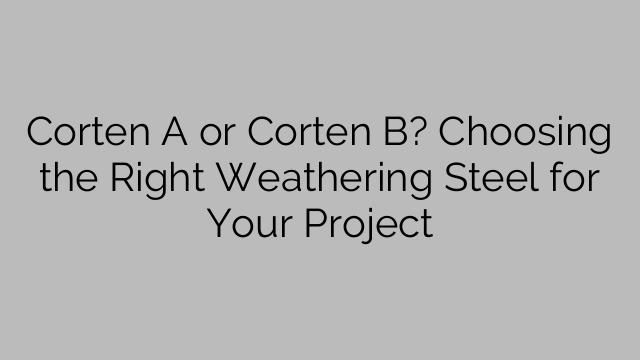Corten steel, also known as weathering steel, is a group of steel alloys that form a stable rust-like appearance when exposed to the elements. This corrosion-resistant feature is achieved through the addition of certain alloying elements, such as copper, chromium, nickel, and phosphorus, which promote the formation of a protective oxide layer on the steel surface. This oxide layer not only acts as a barrier against atmospheric corrosion, but also contributes to the steel’s unique aesthetic appeal.
Corten A and Corten B are both types of weathering steel, but they differ in terms of composition and mechanical properties. Corten A contains a higher amount of copper, while Corten B has slightly more phosphorus. This difference in composition results in varying levels of corrosion resistance and mechanical strength.
Corten A is known for its higher corrosion resistance, making it particularly suitable for applications in harsh or marine environments. It is often used in structures such as bridges, railroad cars, and buildings exposed to high levels of humidity or saltwater spray. Corten A also offers good mechanical properties, such as high tensile strength and yield strength, which make it a reliable choice for structural components.
On the other hand, Corten B is preferred in applications where higher mechanical strength is required. It has a slightly lower corrosion resistance compared to Corten A, but still provides sufficient protection against atmospheric corrosion. Corten B is commonly used in load-bearing structures, such as transmission towers, as well as in architectural components, such as cladding panels and roofing systems.
When choosing between Corten A and Corten B, it is essential to consider factors such as environmental conditions, load requirements, and design considerations. If your project is located in a harsh or marine environment with exposure to high levels of saltwater spray, Corten A should be the preferred choice due to its superior corrosion resistance. However, if your project requires higher mechanical strength, Corten B would be more suitable.
In addition to their functional properties, Corten A and Corten B offer distinct aesthetic qualities. The rust-like patina that develops on the surface of weathering steel gives it a unique and organic appearance, often referred to as a “living finish.” This distinctive look has made Corten a popular choice among architects and designers, who appreciate its natural beauty and ability to blend harmoniously with the surrounding environment.
In conclusion, weathering steel, specifically Corten A and Corten B, offer an excellent combination of corrosion resistance, mechanical strength, and aesthetic appeal. By understanding the differences between these two grades, you can make an informed decision and choose the right weathering steel for your project. Whether you prioritize corrosion resistance or mechanical strength, both Corten A and Corten B provide reliable and durable solutions for a wide range of applications.
[ad_2]

